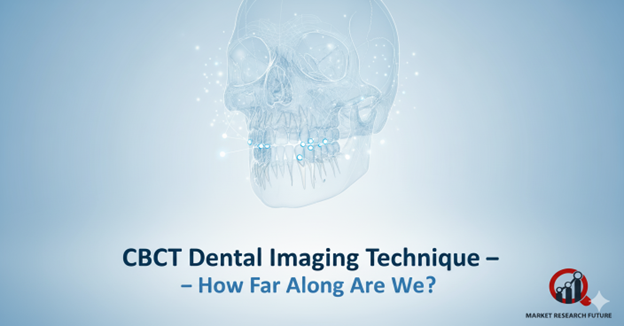
CBCT Market Overview
The global CBCT (Cone Beam Computed Tomography) dental imaging market is witnessing robust growth, driven by rapid technological advancements, increasing adoption of 3D imaging in dentistry, and rising demand for precise diagnostic solutions. Over the past decade, dental radiographic imaging has transitioned from conventional two-dimensional methods to advanced three-dimensional modalities—positioning CBCT as the gold standard in diagnostic maxillofacial imaging.
CBCT systems provide highly detailed 3D images of teeth, soft tissues, bone structures, and nerve pathways in a single scan, enabling accurate diagnosis and treatment planning. These systems are increasingly being integrated into dental clinics, specialty hospitals, and laboratories due to their superior precision, reduced radiation exposure, and faster imaging capabilities compared to traditional CT scans.
The North America CBCT dental imaging market continues to dominate globally, supported by a strong network of dental specialty centres, rising awareness of advanced imaging techniques, and favourable adoption trends across private dental practices. Leading manufacturers such as Danaher Corporation, Planmeca OY, and Dentsply Sirona are spearheading innovation through product development and integration of Flat Panel Detectors (FPDs)—a next-generation technology offering superior image quality and minimal degradation.
Market Growth Influencers
1. Technological Advancements
The evolution from image intensifiers to flat panel detectors has significantly improved image quality, minimized degradation, and enhanced diagnostic clarity. FPDs leverage amorphous silicon and solid-state technology to produce high-resolution digital images, enabling clinicians to capture precise anatomical details and improve treatment outcomes.
2. Rising Adoption in Clinical Practice
The use of CBCT imaging is expanding rapidly across dental specialty hospitals, academic institutions, and private clinics. In the U.S. alone, approximately 800 CBCT units are sold annually, with projections suggesting that over 50% of digital panoramic devices could be replaced by CBCT systems within three years.
3. Expanding Applications
CBCT imaging is being increasingly utilized in orthodontics, implantology, endodontics, and oral surgery, where accurate spatial visualization and volumetric analysis are critical. Its ability to reconstruct images in three dimensions offers superior diagnostic capabilities compared to traditional 2D radiographs.
4. Radiation Dose Efficiency
CBCT systems offer a lower radiation dose compared to conventional CT scans—ranging from 29 μSv to 477 μSv—making them a safer alternative for patients while maintaining high imaging precision. Advanced collimation and voxel resolution further enhance safety by focusing radiation only on areas of interest.
5. Product Innovation and Market Competition
Manufacturers are actively launching next-generation CBCT systems with enhanced features such as adjustable Field of View (FOV) and intelligent motion correction. For instance, in March 2017, Planmeca OY introduced Planmeca Viso, integrating smart imaging technologies that enhance patient comfort and diagnostic accuracy. Such innovations are driving competitive differentiation and fueling market growth.
Market Segmentation
By Detector Type:
- Image Intensifiers
- Flat Panel Detectors (FPDs)
By Application:
- Orthodontics
- Endodontics
- Implantology
- Oral & Maxillofacial Surgery
- General Dentistry
By End-User:
- Dental Clinics
- Hospitals
- Diagnostic Centers
- Academic & Research Institutes
By Region:
- North America
- Europe
- Asia-Pacific
- Latin America
- Middle East & Africa
Regional Insights
North America leads the global CBCT dental imaging market, driven by a strong base of dental institutions, high adoption rates among private practices, and rising preference for 3D imaging solutions. The U.S. remains the largest market, with widespread replacement of traditional panoramic systems by CBCT units. Europe follows closely, supported by technological advancements, regulatory support for digital imaging adoption, and growing emphasis on early and accurate diagnosis.
The Asia-Pacific region is poised for rapid expansion due to increasing awareness of advanced dental technologies, rising disposable incomes, and growing numbers of dental professionals adopting modern imaging systems. Emerging markets in Latin America and the Middle East & Africa are gradually embracing CBCT technology, aided by urbanization, improved healthcare infrastructure, and increased investments in dental care services.
Key Market Players
The global CBCT dental imaging market is shaped by several major players, including:
- Danaher Corporation (U.S.)
- Planmeca OY (Finland)
- Dentsply Sirona (U.S.)
These companies are at the forefront of innovation, introducing systems with enhanced image clarity, lower radiation exposure, and advanced digital capabilities. They are also focusing on expanding their product portfolios, offering customizable imaging solutions, and strengthening global distribution networks.
Conclusion
The CBCT dental imaging market is evolving from a niche diagnostic tool into a mainstream clinical necessity, offering dentists superior imaging capabilities, precise diagnostics, and enhanced patient outcomes. With continued technological innovation, declining radiation exposure, and expanding clinical applications, CBCT systems are set to replace traditional imaging techniques across the globe.
As the industry advances, ongoing product development and strategic partnerships will be pivotal in shaping the next phase of growth—particularly in North America and Asia-Pacific—solidifying CBCT’s position as the standard of care in modern dentistry.
About Market Research Future (MRFR)
Market Research Future (MRFR) is a trusted global market research firm dedicated to providing accurate, data-driven, and actionable intelligence across industries. With a focus on transparency, precision, and client-centric insights, MRFR’s comprehensive reports empower businesses, investors, and policymakers to make informed strategic decisions.
By combining in-depth analysis, market forecasting, and trend evaluation, MRFR serves as a reliable partner in navigating the complexities of global markets and identifying emerging growth opportunities.